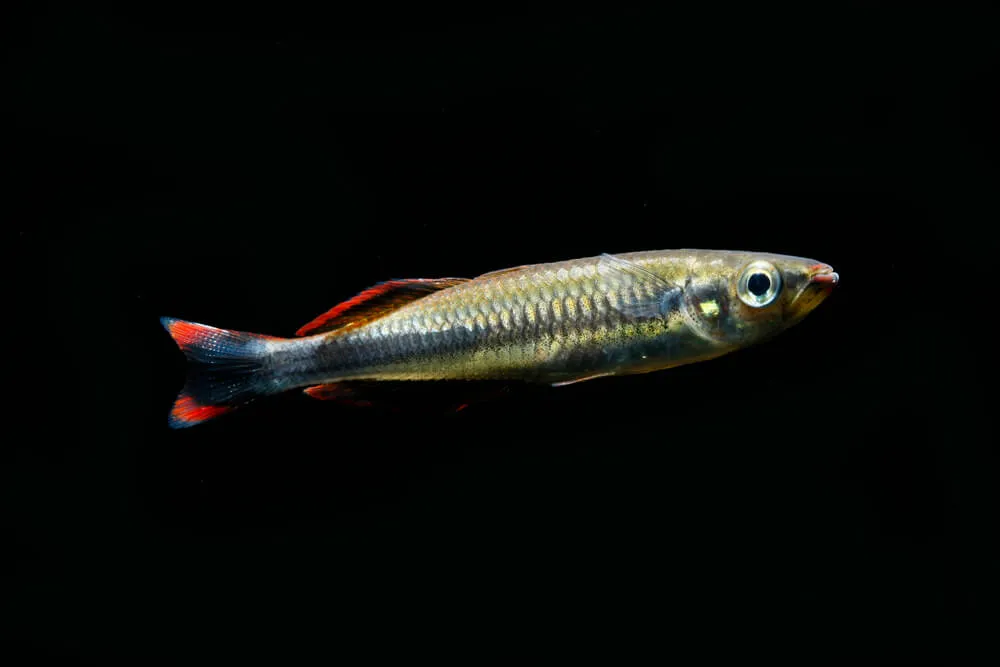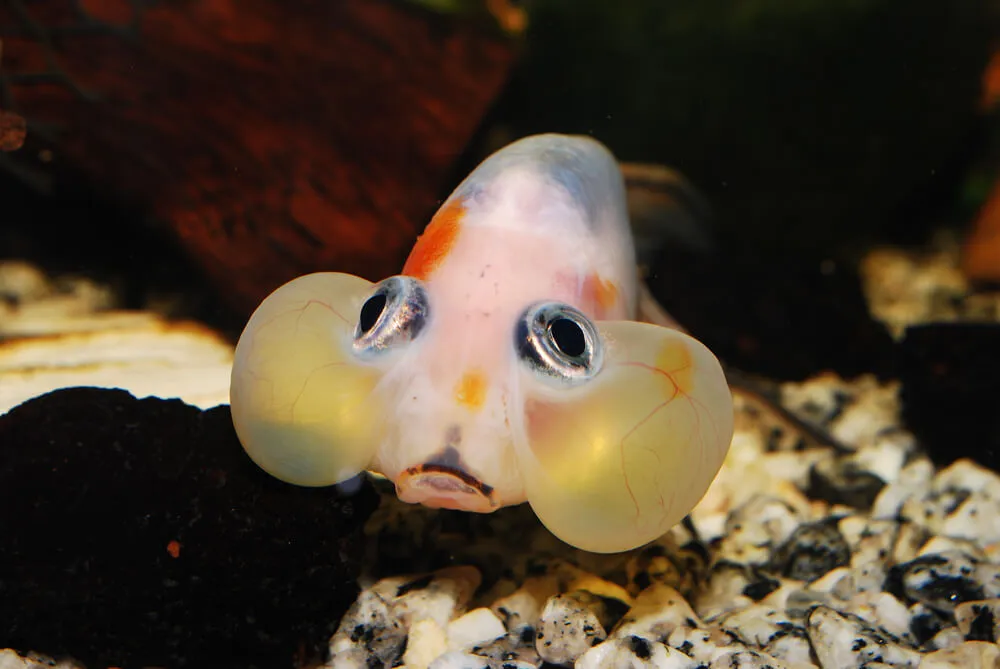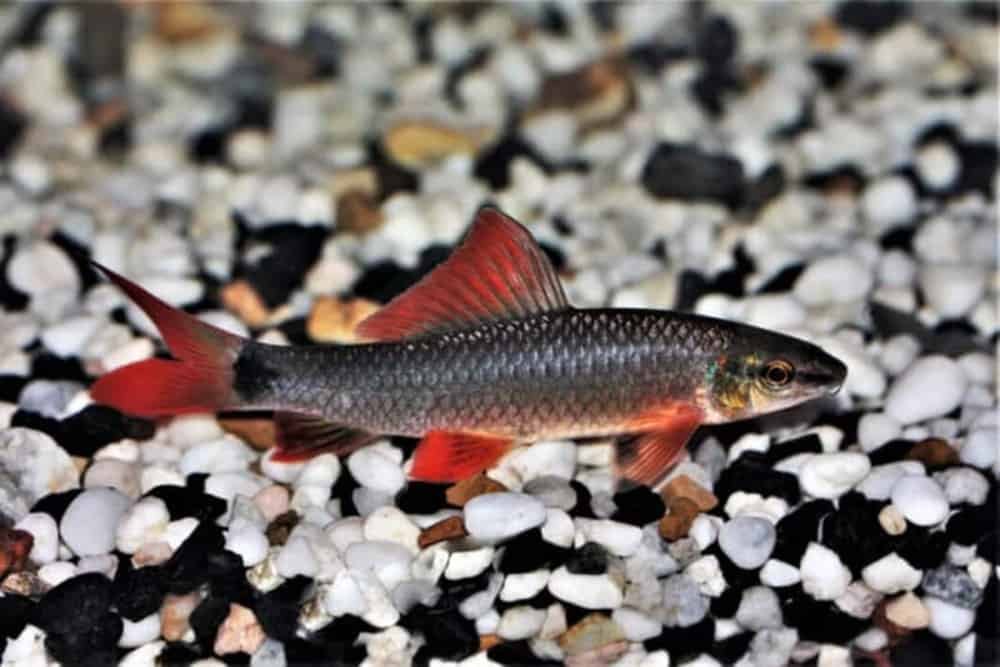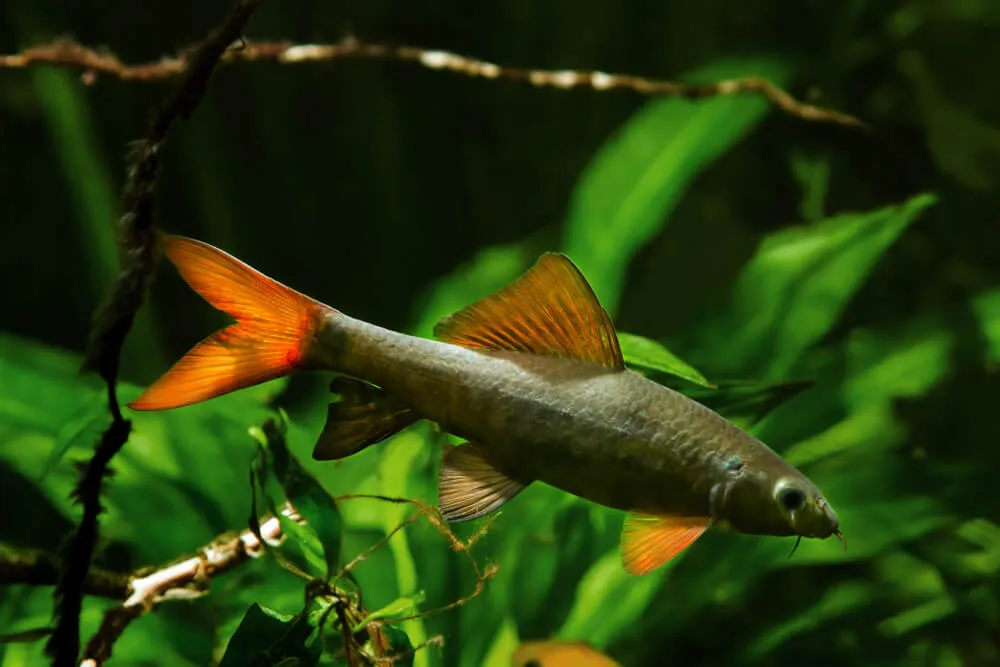Madagascar Rainbow Fish is undemanding and relatively hardy, making them perfect for pros and aquarium hobbyists looking for calm yet charming species. They thrive well in different aquarium conditions as long as there is slow water movement.
The fish can last from 5 to 11 years when properly cared for and grow up to 5.9 inches. These fish thrive in slightly alkaline hard water in tanks with a 30-gallon capacity.
Madagascar Rainbow Fish – Overview
This fish species with the scientific name Bedotia geayi originated from the river in Madagascar called Mananjary and other river basins, including Onilahy, Mangoro, and Sambirano.
The fish also goes by other names, such as Malagasy Rainbowfish and Madagascan Rainbowfish. They were first discovered in 1907 but are now among the most popular fish among aquarists.
It has a rainbow-colored body, hence the name. This freshwater fish from the Bedotia genus has at least three species, but only the Madagascar Rainbowfish is traded in the aquarium industry.
The colorful appearance of the fish can make many people feel lighter, but they may be at risk of getting endangered in the years to come. Aside from pollution, their natural habitats are under threat of human activities, including deforestation.
Here’s a quick overview of this fish species:
Size: 5.9 inches
Min Tank Size: 30 gallons
Temperament: Peaceful
Diet: Omnivorous
Care Level: Easy
This exotic fish is easy to care for, and its best tank mates are the species with a similarly peaceful and calm temperament.
Appearance And Colors
The fish have a strong but short dorsal fin and long, slender body.
They have large mouth and eyes with a coloration that range from gray to silver. The body has a light blue sheen and an overall slightly brown and yellowish hue.
They are nice to look at when they swing their dorsal fins as they have more depth in terms of colors. The entire body length of the fish sometimes shows a dark blue stripe. You will also notice a shorter string beneath the one running its entire length.
The males are more colorful, with their coloration ranging from orange to red on their heads and dorsal fins.
The Size And Ideal Tank
The Madagascar Rainbow Fish’s length is about three to four inches. They will thrive in a 30-gallon fish tank, but if you want them to live longer, the ideal tank size is 50 gallons.
They need ample space since they mostly feed on live foods. Bigger aquariums will make it easier for tank owners to add feeder fish.
This fish type is active during the day and loves to swim. It will help if the aquarium is long.
Aside from the tank’s size, you must put plants and a good filtration system to keep the water’s oxygen levels high.
The fish will love highly decorated tanks, so they will have many areas to hide and play. They also tend to jump, so ensure that your tank has a tight-fitting cover.
Here are the things you need to remember in setting up an ideal tank for this fish:
1. Size
As already stated, the ideal tank size is 30 gallons, but the bigger the tank, the better for this species since they will have more room to move around, swim and play. They will be more comfortable in a 50-gallon tank.
But you can settle for a 100 to 150-gallon tank if you intend to keep full-grown fish in it along with other species as tank mates.
2. Lighting
The tank needs moderate lighting with lots of shaded areas.
3. Substrate
They prefer a darker substrate, like a combination of gravel and sand.
4. Filtration
It is best to include several powerheads in the tank to keep the water movement moderate.
5. Water Parameters
Keep the water hardness at around 8 to 25 dGH for moderately hard water. As for the pH, keep it within 6.5 to 8.5 as they like slightly alkaline water.
6. Temperature
They will thrive well at water temperatures within 72 to 77 degrees F.
General Behavior
These fish species are generally calm and peaceful. You will have no problems placing them in community tanks along with non-aggressive, small fish.
They will likely get stressed when placed in a tank along with fish that are too active and tend to nip at their companions’ fins. It is also not advisable to put them along with slow-moving and smaller fish varieties since they can’t compete with the rainbowfish in getting food, which may result in the smaller fish becoming undernourished.
The mature male rainbowfish can be aggressive and territorial with one another. To keep them safe, it is recommended to keep one male of this kind in each aquarium.
Rainbowfish prefer hiding in the thick vegetation in the tank and won’t likely cause trouble as long as you keep them with similar-sized fish with the same temperament.
They are also naturally schooling fish, meaning they enjoy hanging out in groups of the same species. Keeping at least six of them in the same tank is best to help them feel more comfortable and happier.
General Diet And Food Guide For The Madagascar Rainbow Fish
The species are omnivores, so you won’t have a hard time feeding them. They will eat anything you give them, including plants and small insects.
They also love live foods, such as water fleas, brine shrimp, tubifex worms, and bloodworms. You can also add vegetables and algae wafers to modify their diet once in a while.
Live prey will make them feel like they are on their natural habitat. But to keep them healthy, you have to constantly give them high-quality flake food or pellet.
The fish will devour on frozen or live foods. If you want to make their colors brighter, you can include meaty and protein-rich foods to their diet.
It is not advisable to feed them one large meal everyday. It is better to feed them several times in a day.
Giving them supplements will also help in making them live longer and healthier. You can give them supplements at least twice each week.
Caring Tips For Your Rainbowfish
The fish easily adapts to any tank condition, but to help them thrive longer, you must give them ample space and plenty of hiding places, such as rocks and plants.
A good current in the aquarium will make the fish feel like they are in their natural habitat. You can also simulate the habitat by submerging some bogwood or driftwood into the tank.
Continually monitor your fish for any signs of illnesses, so you can isolate and care for them before it is too late.
Here are the other things you need to know about the fish species to care for them properly, keep them healthy, and extend their lives:
1. Breeding
They are livebearers and naturally spawn when the water level is high or after heavy rainfall. However, it can be difficult to breed them while in captivity.
Many beginners find it challenging to breed the species, so most of them generally keep the fish for experience and because they enjoy their beauty.
Take note that the female fish will outgrow the males to the point that they will get uncomfortable in the tank.
The male fish extend their fins to the female fish during courtship. It’s like asking them to dance, but the act actually initiates mating.
The male fish swim closer to their partners while keeping their fins extended, and they will swim together when they are ready to begin spawning.
They will continuously spawn for some weeks. The female fish release one to two eggs at a time, which the males place on rocks or plants to fertilize.
The eggs typically hatch after a few weeks. However, these fish tend to ignore their eggs and fries.
To keep the young fish safe, you must separate them from their parent fish. Take note that the process of growth of the fries takes time.
The fries will eat the egg yolk’s sac initially after hatching. After some time, you can feed them with infusoria or liquid fry food.
While still young, giving the young fish brine shrimp is not recommended. You can do so as they get older.
Breeding the fish while in captivity can be done, but it requires great effort as the fish and the young are sensitive. The fries would need attention to see that they get the nutrition they require.
2. Common diseases
While they are hardy, the fish can also become sick, especially when you don’t maintain a good tank condition all the time. It is best to learn about the common disease the species may acquire and what to do when it happens:
- Skin flukes
You will typically see tiny black dots on the skin and clamped fins on fish infected by the disease. However, the dots on the skin may only be visible if you look into your fish using a magnifying glass.
You can prevent the disease from happening by not adding any stressors to the tank and keeping it constantly clean.
- White spout disease (ICH)
You will see tiny white spots on the skin’s fish infected with the disease. While it can be easily cured, you have to spot the problem while it is still in its early stages.
If you fail to notice that your fish have ICH and treat them later, they may die. You can also prevent the disease by keeping the tank clean and stress-free.
- Parasitic infestations
Among the many parasites that can affect this fish species is Hexamita. The infestation is manifested by the fish’ lack of energy and weight loss.
Prevent the parasite from infesting the water in the tank by keeping it clean. You also have to do everything to keep the tank conditions in top shape at all times.
- Hole in the head
When your fish has the disease, you notice a hole between its dorsal fin and head. The condition can be caused by the presence of a high organic matter in the tank, stress, or poor diet.
However, it’s a rare disease but can also be fatal when left untreated. Keeping the tank clean can also help prevent the disease and ensure that the fish is provided with a variation or good and healthy diet.
- Bacterial infections
The condition is rare but can happen when the tank is left unmaintained. The usual symptoms of the disease include the fish’s lack of energy, clamped fins, and cloudy eyes.
If you encounter this problem, cure the tank first using salt. You can then treat the fish infected with the bacteria with an antibiotic.
Ideal Tank Mates For Your Madagascar Rainbowfish
You can easily keep the fish with any species, as long as they are peaceful, similar in size, and do not nip dorsal fin. The Madagascar Rainbow Fish makes an ideal addition to any community tank.
Aside from having an identical size, their ideal tank mates need to have a similar activity level and temperament.
The rainbowfish will keep in their group and won’t interfere with the other fish in the tank. But you have to ensure they have plenty of space to swim.
They swim fast, making slow-moving fish intimidated and nervous around them. On the other hand, if you want to add them with semi-aggressive fish, make sure that you monitor the tank often.
Replace the fish once you see any signs of aggression. Rainbowfish also feel stressed and threatened by other species that are naturally aggressive.
The most suitable tank mates for your rainbowfish include the following:
1. Dwarf Cichlids
Size: 2.3 to 4 inches
Min Tank Size: 20 gallons
Temperament: Generally peaceful
Diet: Omnivorous
Care Level: Moderate
The term dwarf cichlid refers to all members of the cichlid family. They are small, hence the name, and endemic to West and South Africa.
South American dwarf cichlids have varying patterns and colors. They are highly adaptable, generally peaceful, and peculiarly small.
Similar to Madagascar Rainbowfish, they lack aggression, making them an ideal addition to community tanks. The color and appearance make them nice to look at, especially when in the same tank as the rainbowfish.
The lifespan of this fish can range from five to ten years. Unlike the rainbowfish, the female dwarf cichlids are bigger than the males.
The female fish have a dull color with a black stripe throughout its flanks. The male fish feature bright yellow and red colors.
The fish enjoy swimming like rainbowfish. However, you have to look for any signs of stress. The fish tend to nip on their tankmates when triggered.
They also show signs of being territorial and aggressive when breeding.
The fish are generally peaceful but shy. They do not swim in schools and would rather hide among rocks or plants where they feel safer.
They are active in the day and would come out during feeding time. You will notice the fish not making any movement when they sleep at night or even during the day.
They have the same diet as the rainbowfish, so feeding them won’t be a problem. Dwarf cichlids eat frozen or live food and tropical flake food. You should also give them high-quality pellet or flake food to sustain their health and occasional live food, such as blackworms, brine shrimp, and bloodworms.
They are also prone to diseases similar to most conditions encountered by rainbowfish. But most of them can be handled through chemical filtration and frequent water changes.
2. Cory Catfish
Size: 1 to 4 inches
Min Tank Size: 10 gallons
Temperament: Peaceful
Diet: Omnivorous
Care Level: Easy
Cory catfish pertains to a group of above 160 freshwater fish of this kind. They mostly dwell at the bottom of the tank.
They have whiskers or barbels around the mouth, have black spots on their white bodies, and have short faces.
They will thrive well with Madagascar rainbowfish due to their calm and peaceful temperaments.
When fully grown, the species will reach up to four inches long. Their lifespan is up to five years, but it will still vary depending on the species.
The fish have neutral colors, like gray, black, or brown, with different patterns. They spend most of their time digging in the substrate or hiding in caves.
The colors of these fish tend to become paler when they are stressed. There are also instances when they change their colors to camouflage or blend into their surroundings.
The plates or bony scales they have on their skin serve as their armor or protection. They use the barbels on their faces to dig food in the substrate.
They are also active during the day, like the Madagascar rainbowfish, and they sleep at night, making them diurnal.
The fish get stressed when the water has high nitrate levels, which can also cause infections to the fish. Always check the level of nitrates in the water and keep the tank clean.
3. Black Ruby Barbs
Size: 2.5 inches
Min Tank Size: 20 gallons
Temperament: Peaceful
Diet: Omnivorous
Care Level: Very easy
These are schooling fish that thrive well with other small fish. They are also well-loved due to their cuteness and color.
You will have no problems adding them to community tanks. However, they are already considered extinct due to heavy deforestation and other harmful human activities to nature.
These barbs can live only as long as five years. Aside from their peaceful nature, the fish are not demanding and easy to care for.
Since they are schooling fish, you have to add them to the tank in groups. You can add a minimum of six of them, but they will be happier if you add more.
Since their natural habitat comprises river beds with natural substrate, you can imitate that by laying sand or gravel in the tank, which your rainbowfish also prefer.
The black ruby barbs are also shy, so you have to put decorations and plants where they can hide. They prefer water temperature that is not too warm, which can be about 72 to 79 degrees F.
They love vegetables since they often eat detritus and algae in their natural habitat. But you can also give them other foods you feed your rainbowfish, such as meat and live food, including bloodworms and daphnia, and shrimps.
You can also give them fish flake foods. However, ensure that their diet mainly comprises vegetables, including spinach, peas, raw zucchini, and blanched lettuce.
Frequently Asked Questions
Where can I buy these fish, and how much do they typically cost?
It’s easy to find them in many fish shops. However, if you are planning to breed the fish, it is best to look for a specialized breeder who can teach you what to do to succeed in the venture.
The price of these fish can range from $20 to $50. You can also find more expensive types considered premium due to their brighter color and top-notch health condition.
What part of the tank does these fish often swim in?
They like swimming near the bottom and sometimes in the middle part of the tank. As they grow older, they spend more time in the deeper part of the tank.
How many of these fish should I get in a tank?
They are school fish, so you must keep at least six of them together in a tank. They also tend to get shy, so ensure they are never alone with other fish species in the tank.
Final Thoughts
The Madagascar Rainbowfish are beautiful fish species with a calm and peaceful temperament. They are easy to care for as long as you feed them right and clean the tank regularly.
You can add them easily to community tanks, along with similarly-sized fish with the same temperament, including dwarf cichlids, cory catfish, and black ruby barbs.
Hopefully, this article has helped you decide whether or not you and the rainbowfish are a perfect match. If you are, you can start small but ensure that you will get a minimum of six of these fish so that they won’t feel lonely in the tank.







